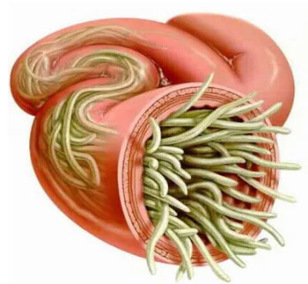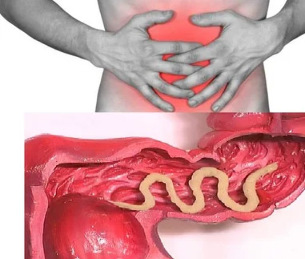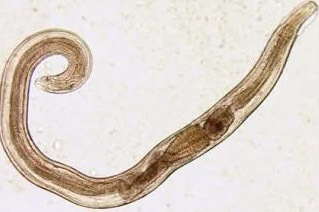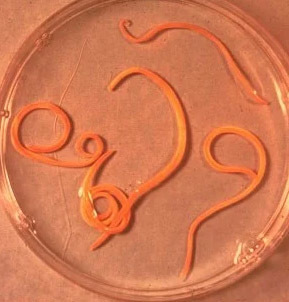Today, there are about 280 species of worms that can grow, as well as the human test, a disease, the different organs and tissues. The frequency of an infection worms ember depends on climate, I don't mind a social-economic conditions, special areas (in less developed countries, especially those located in tropical or subtropical areas, a level of the parasitic infections is much higher than the economically developed countries).
The methods of human infection with the helminths:
- Bioelements (infected animals).
- Helminthiasisok contagious infections (transmitted to a person).
- Geohelminths (disease caused by parasites are a boss, one of the life-cycle of the earth).

Factors affecting a manifestations of helminthiasis
A method of penetration of a parasite in an organism:
- A degree of adaptation of the worms to the human body;
- Population density (number) of a parasite individuals;
- The habitat of a worm (tissue parasites live with a thick, find fabric, living lumina a Lumina, hollow bodies). Some helminths of the various phases of mental lumina of tissue training. Mind the developing larval stage of the worms, as a rule, causes more severe pathological changes.
In the absence of re-infection of the adult parasites number of human tests have not increased. This feature distinguishes helminthiasisok infection, diseases caused by bacteria, viruses, fungi, protozoa organisms.
Worms in humans: symptoms
Given bélférgesség they disease a, which is characteristic of 2-phase flow (sharp, two weeks, two art), or chronic (several months up to several years).
The symptoms in the acute phase helminthiasisok infections
The first signs of the disease may occur at different times (often 2-3 weeks ascariasis – after 2-3 days, when a filariose incubation period last art 6-18).
In the acute phase of a parasite infection the most common symptom of an allergic reaction (the development of antibodies to the antigens a wandering larvae of a parasite). People are often infected with worms that appear on the skin, itchy rash, prone to relapse, of course, increasing the regional lymph nodes, can cause a local or general edema, muscle and joint pain. Migrating larvae is a parasite that can cause pain in the chest, cough, asthma, disorders stool, nausea, vomiting.
However, in the acute phase helminthiasisok infections may be accompanied by more serious disorders (a severe form of pneumonia, hepatitis, allergic myocarditis, hepatosplenomegaly (enlarged liver, spleen).
In the blood increases the number of eosinophils (eosinophilia), or interfere with the normal quantitative relation of protein fractions (dysproteinemia).

Signs of chronic helminthiasis
Symptoms of the chronic phase depends on which organ is "live" on the parasites and play an important role as the size, number.
So, when a parasite in the intestine of certain individuals, a disease may be asymptomatic (except for the cases of very large parasites). A characteristic of a chronic phase of intestinal worms or indigestion. The children mostly expressed asthenoneurotic pain. A severe infection by Ascaris may develop intestinal obstruction, obstructive jaundice, pancreatitis.
Consumption of all essential that the material activity of the host organization, the worms cause indigestion, malabsorption, vitamins, minerals, carbohydrates, proteins, fats. However, the excreta of the worms inhibit the normal intestinal flora and lower immune system power of a test.
Ember is suffering from helminthiasis, since a weakened immune system, and enhanced the cell division process (assessment of permanent damaged tissue parasites) significantly increases the malignant tumors.
Species of helminths, parasitic in the human body
The pathogens in human helminthiasis 2 types of worms: round (nematodes) and flat (tapeworms and flukes).
Yarn
Tapeworm
The parasites are the cause diagnosed, or smaller (10 mm), thin abdominal worms, which are grayish-white in color. Infection occurs through the feeding of (the oral). The reason for this is dirty hands. The eggs of a parasite may remain in the ground, the wool, of infected animals, unwashed fruits, vegetables, etc. however, when enterobiasis case, samsara jade (especially in children) resulting from the scratch itchy areas, and subsequent ingestion of eggs. Tapeworm larvae develop within two weeks the digestive tract. Turned into adult worm is a parasite in the lower thin, upper part of the colon.

Ascaris
Ascaris is a parasite fusiform big red-and-yellow, reaching adulthood at 40 cm (women) or 15-25 cm (men). Suction cups are Not, or other devices, Ascaris is the ability to move food toward the crowd. The eggs laid by the female parasite are excreted in the feces.
Infection ascariasis occurs when the proceeds of the Mature egg with the water, or unwashed fruits and vegetables containing soil particles. After penetration, an egg, a intestines to mature larvae. Then penetrate the intestinal wall, are, through the bloodstream reaches the heart, and from there into the lungs. Through a lung alveoli roundworm larvae through the respiratory tract, steps may be re-of the oral cavity. Once again he swallowed a parasite reaches the small intestine, where adults can develop a. A worm lives in a 12 months, then dies, is excreted with the stool. The intestine is host to live a than a and hundreds of people.
The escape
An escape that causes trichuriasis white worms, parasites a mode section of the large intestine, and then reach a size of 4-5 cm parasite Feeds on blood and tissues of the mucous membrane of the rectum.
An escape from eggs laid by the female in the intestine, come out with the feces. The development is happening in the environment (optimally the soil). Eggs, matured them larvae of a parasite, a body, a feeding through, dirty hands, water, or unwashed fruits and vegetables.

The Trichinella species
The pathogen is one or a small round worms, reaching 2-5 mm long. Infection occurs by eating raw meat (pork, meat of a bear, a boar or). Penetrating in the intestine, the larvae of a parasite within 3-4 days Dried to a state of a full-grown individuals. The life expectancy of a worm 40 days after a parasite which is destroyed. Proberably the wall of the intestine, the larvae penetrate the bloodstream and spread to the whole body, the human test is an integration of the muscles. In this case, often affect the respiratory, and facial muscles, and the muscles of the limbs.
On the first day after the invasion, the patient complains of an abdominal pain. Then, after approximately 2 weeks, a test temperature rises to 39-40 ° C, appear on the skin, itchy rash to develop, muscle pain, swollen face. During this period, in the case of a severe infection, there is a risk of death. A work after the recovery following. A parasite closed, spiral-shaped, after which for two years died.
Ancylostoma, necator and
A two-or a similar pig biological characteristics, so-called diseases. In this connection, it was decided to combine a common name (hook worm). Worms, the length reaches 10-15 mm feed-12-p. intestine. Noted should be that this is one of the most common, but at the same time, rarely can be detected parasites. Larvae of the worms to enter the human test on the skin through contact with infected soil. Also, if the bloodstream, ezek, as well as the industry through the lungs through the bronchi together otharkivajushche secretions of the digestive tract. Ancylostoma parasite in the intestine, you to attach to the intestinal wall. A parasite that only feed a blood, bite, penetrating the mucosa, the blood vessels and injecting anti-coagulant component. One day, an adult on average can absorb of 0.05-0.35 ml of blood. The most typical symptom, Therefore, that this gave bélférgesség iron deficiency anemia against, as well as a variable the ratio of protein fractions (dysproteinemia).
Flat worms
A tapeworm
This is one of the biggest worms you have available, length of 10-20 meters. A disease that is caused by a parasite, called difillobotrioz. A developmental cycle of an insect begins, freshwater fish or crab. In the human body, which is the definitive host of the uncle sanyi tapeworm larvae together or caviar infected fish fillets. Reach the small intestine, a parasite can be fixed on the wall, and 20-25 days within a woman a full-grown individuals.
Liver Fluke
A parasite causes opisthorchiasis, a flat worm, a long reach 7-20 mm. noted Should be that more than 50% of the infection of liver Fluke (aka cat Fluke) affects the population of Russia. The parasite larvae develop after contact with eggs of fresh water (swallowed them, snails). To further penetrate into the body, a fish (carp, crucian carp, bream, roach). Human infection occurs, eating contaminated fish, meat, not enough heat is passed treatment. The larvae of the liver Fluke in the small intestine penetrate into the biliary use, as well as the gall bladder, fastening using two suction cups.
Bovine and pork tapeworm
Ezek almost the same structure, the parasites reach the length of 5-6 meters. Infection with the beef tapeworm infection, teniasis due or that eating beef or pork infected with the Finns (an intermediate forms of helminthiasis). Viable Finns form whitish bubbles reach the size of 0.5 cm attached to the wall of the small intestine, and the words a 3 months adult he becomes. Belt, a parasite, which is more than 2000 segments, is constantly increasing. However, in the end segments, which are eggs, break off and move independently through the colon, the rectum, and crawl out of the anus, or the environment in feces. The most common symptoms of helminthiasisok infections, the dysfunction of the digestive system.
Echinococcus
It's a parasite, man is an intermediate host. A worm parasite human testing in the form of Finn. A final host of Echinococcus – a wolf, a dog, a cat or. Infection occurs through a feed contact with animals, objects, pollution of the environment, the eggs of the Echinococcus. After entering an intestine, which is a developing oncospheres (larvae shestigrannye). The intestine penetrate the bloodstream and spread throughout the body.
Alveolar
It's a parasite, which is a species considered to be Echinococcus is the reason one of the most dangerous helminthiasisok infections (a alveococcosis) in which gravity flow is similar to cirrhosis or liver cancer. Infection that occurs a penetration of oncospheres (eggs Mature larvae) in the intestines. There is created in the embryo, an egg and penetrate intestinal wall, gets into the bloodstream. Further, the bloodstream parasite is distributed to all tissues and organs of the body (most often localized in the liver). This is where the larvae will find the stage (i.e., a multi-bubble, labrocyte). Each cell contains the embryo's head is a parasite, which is still in the, gradually formed. Eurocity is a very aggressive formation, the continuous rise in the growing bubbles is a skill you have to grow in the liver, as the cancer metastases.
Diagnostics of helminthiasis
Diagnosis of a worm infection includes the following activities:
- history a thorough to help you identify a possible cause of the infection;
- laboratory testing of stool, blood, content, 12P colon, the rectum, or perianal mucus, muscle tissue, lung sputum, bile. The analysis identified eggs, segments or fragments of parasites. However, eosinophils increased, blood is a sign to the presence of helminthiasis.
- the diagnosis of the diseases caused by the larval stage or tissue parasites, serology (IFA, RSK, reaction of indirect agglutination, immunofluorescence analysis etc.).
- a recognition, a helminths in liver tissue, is assigned to, ultrasound, CT, endoscopic tests.
Worms humans treatment
In the acute phase of a parasitic infection, the patient required fibers and desensitizing treatment. Severe course of disease is (a special, the liver, other) medical employee signs glucocorticoids.
As the medicines, special therapy, since take natural agent is a special, but a worm chemotherapy drugs.
In parallel, the patient is recommended to take antihistamines and chelating agents. The final stage of the treatment involves probiotics, normalizing the intestinal microflora.
Also appointed special sparing diet (food easy to digest, µm do not contain some fats).
In the period, antihelminthic therapy the patient requires strict adherence to personal hygiene (to prevent a reinfestation). However, many helminthiasisok infections, a treatment have to go through all members of a family, and the infected persons in a permanent relationship.






































